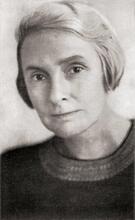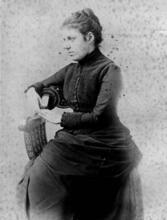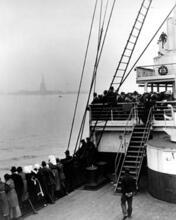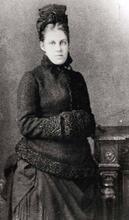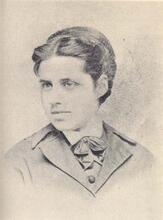Emma Lazarus
Emma Lazarus (1849-1887), an internationally known poet and essayist, created the role of the American Jewish writer. She lent her voice to the Statue of Liberty to enunciate a vision for America, but she herself was in no doubt about the Jewish roots of her vision in tikkun olam (repairing the world) through righteousness, justice, and compassion.
Family & Education
Born on July 22, 1849, Emma Lazarus was the fourth of Esther (Nathan) and Moses Lazarus’s seven children. Her ancestors had been founders both of the Touro synagogue in Newport, Rhode Island, and of the Sephardic Shearith Israel synagogue in New York, where her uncle, J. J. Lyons, served for nearly forty years as chazzan and spiritual leader. She grew up in New York City and was educated by private tutors with whom she studied mythology, music, American poetry, European literature, German, French, and Italian. Her father, a successful sugar merchant, supported her writing by publishing, when she was only seventeen, Poems and Translations: Written Between the Ages of Fourteen and Sixteen (1866). An augmented version of the volume, dedicated “To My Father,” was commercially published the following year.
Soon after Poems and Translations was published, Lazarus met Ralph Waldo Emerson. The two corresponded until Emerson’s death in 1882. During the early years of their relationship, Lazarus turned to Emerson as her mentor, and he in turn praised and encouraged her writing. In 1871, when she published Admetus and Other Poems, she dedicated the title poem “To My Friend, Ralph Waldo Emerson.” Despite his admiration, Emerson declined to include Lazarus’s poetry in his 1874 anthology, Parnassus, though he did include other women writers such as Harriet Prescott Spofford and Julia C.R. Dorr. Lazarus, humiliated and wounded, responded with an angry letter, which went unanswered but was among Emerson’s papers at his death. Two years later, learning that Emerson was suffering from dementia, Lazarus visited the Emerson family in Concord, Massachusetts. A letter from Emerson’s daughter, Ellen, records that Lazarus told her that she had been raised “to keep the law,” including Yom Kippur and Passover, but that now her family were “outlawed,” though “Christian institutions” did not interest her either.
Early Literary Work
Admetus and Other Poems includes “In the Jewish Synagogue at Newport,” the first poem in which Lazarus explored the experience of her Sephardic ancestors. This poem echoes in form and meter Henry Wadsworth Longfellow’s “The Jewish Cemetery at Newport,” but where Longfellow’s meditation closes with “the dead nations never rise again,” Lazarus concludes by announcing that “the sacred shrine is holy yet.” Another poem in the volume, “How Long,” proclaims the need for a “yet unheard of strain” suitable to prairies, plains, wilderness, and snow-peaked mountains. This call for a new, authentically American literature, was a theme to which Lazarus would return in an 1881 essay heralding “fresh vitality in every direction.” Here she drew attention to the voices of regionalists, Jewish writers, the scandalous Walt Whitman, and indigenous voices, which Lazarus versified in “The Creation of Man,” a Miwok myth of creation.
Lazarus never publicly criticized either her father or Emerson, but she would ponder the prerogatives of powerful male figures in her works of the 1870s. Her only novel, Alide (1874), based on Goethe’s autobiographical writings, focuses on Goethe’s spurning of a country woman to fulfill his “sacred office.” In 1876, Lazarus privately published The Spagnoletto, a tragic verse drama about father-daughter incest. Throughout the 1870s and early 1880s, Lazarus’s poems appeared in mass-circulation American magazines. Among these are “Outside the Church” (1872) in Index; “Phantasmagoria” (1876) and “The Christmas Tree” (1877) in Lippincott’s; “The Taming of the Falcon” (1879) in the Century; and “Progress and Poverty” (1881) in the New York Times. She wrote in a wide variety of verse forms and composed the first prose-poem in English, “By the Waters of Babylon,” a poem about the exile of Jews from Spain. Her writing reached a wider American audience than that of any other Jewish American writer.
Jewish Themes
Though Lazarus wrote in 1877 that “my religious convictions ... and the circumstances of my life have led me somewhat apart from my people, ” by that time, she was already publishing poems with Jewish themes, including “Vashti,” in Henry Ward Beecher’s Independent and two monologues based on Heine’s poem “Donna Clara” (which she translated) about the crypto-Jewish lover of a Spanish noblewoman. That summer, a chilling rise of genteel anti-Semitism in New York and environs dismantled Lazarus’s illusions about America’s acceptance of its Jews – even a fourth, if not fifth-generation, assimilated American Jew like herself.
But it was an outbreak of antisemitism in Eastern Europe, manifested in the Russian pogroms of the early 1880s, that would become a watershed in Lazarus’ identity as a poet, as well as in her personal life. In 1881 and 1882, when Jewish refugees streamed into New York Harbor, Lazarus dedicated herself to aiding them: she visited them at the Schiff Refuge on Ward’s Island, taught them English at the YMHA, volunteered at the Hebrew Emigrant Aid Society (HEAS), co-founded the Hebrew Technical Institute, and advocated for them in both the Jewish press and mainstream magazines. She even started her own fund to help them settle and find jobs. During these years, she wrote the poems of her breakthrough volume,the brashly titled Songs of a Semite (1882), in which she set out to rally complacent American Jews to the cause of Jewish national pride. In “The Banner of the Jew,” she urged “Israel” to “Recall to-day / The glorious Maccabean rage,” reminding readers that “With Moses’s law and David’s lyre” Israel’s “ancient strength remains unbent.” And in The Dance to Death, a poetic dramatization of Richard Reinhard’s 1877 prose narrative Der Tanz zum Tode, Lazarus celebrated the courage and faith of the Jews who were condemned to die in Nordhausen, Germany, in 1349 for allegedly causing the plague. She dedicated The Dance to Death to George Eliot, “who did most among the artists of our day towards elevating and ennobling the spirit of Jewish nationality” with her novel Daniel Deronda.
The same year she published Songs of a Semite, Lazarus adopted a more public Jewish identity in the Century. In “Was the Earl of Beaconsfield a Representative Jew?” (April 1882), she offered an ambivalent portrait of Benjamin Disraeli; she defined “representative” as embodying the best as well as the worst of Jewish traits. In the second essay, “Russian Christianity vs. Modern Judaism” (May 1882), Lazarus wrote a diatribe against an antisemitic, pro-Russian essay (also published in the Century), making an ardent plea for informed understanding of Russian Jews and their situation. And in the third essay, “The Jewish Problem” (February 1883), she observed that Jews, who are always in the minority, “seem fated to excite the antagonism of their fellow countrymen.”
Although Lazarus had published occasionally in the Jewish press, she became a regular contributor to the American Hebrew in the early 1880s. After publishing her book Songs of a Semite, the paper invited her to write a column called “An Epistle to the Hebrews.” In this series of fifteen open letters (November 1882 - February 1883), Lazarus challenged assimilated American Jews to recognize their privileged status and give generously in support of Eastern European Jewish refugees; at the same time, she warned them about their vulnerability as Jews, even in the United States. Early in the series, she argued that Jews could be assured of safety in the United States, Great Britain, Germany, and France, but in the final weeks of her column her view darkened. Years before the emergence of modern Zionism with Theodore Herzl’s book Der Judenstaat (The Jewish State 1896), she spoke ardently on behalf of Jewish “repatriation” in Palestine. For her Zionism, she was ridiculed both by traditionalist Jews, who were put off by her secular patriotism, and by Reform Jews, who feared charges of dual nationality.
The New Colossus
In 1883, Lazarus wrote “The New Colossus” to raise money to build the pedestal for a new Statue of Liberty. Given that she had only seen the statue’s torch – the rest of it lay in storage in Paris – her audacious imagining of the Statue lifting her torch above New York Harbor is impressive. Even more remarkable is Lazarus’s recasting of a statue created to honor French republicanism and abolitionism with a different mission—a Jewish mission: to welcome the stranger. In fact, within days of writing “The New Colossus,” she wrote a companion sonnet, “1492,” which links the fate of Jewish exiles from the Spanish Inquisition to that of the “huddled masses” yearning to “breathe free” on American shores.
“The New Colossus” was singled out and printed in the Catalogue of the Pedestal Fund Art Loan Exhibition at the National Academy of Design (as well as Art Amateur magazine) because event organizers hoped it would “awaken to new enthusiasm” those working on behalf of the pedestal. Soon, however, it faded from view, and when the Statue was dedicated in 1886, her poem was neither read nor mentioned. (Not until 1903, more than fifteen years after Lazarus’s death, did her friend Georgina Schuyler undertake to mount a brass plaque with the poem inside the pedestal of the Statue of Liberty, as a tribute to her late friend.)
Later Life
In 1884, Lazarus returned to the conundrums of the life of Heinrich Heine. She had received high praise for her 1881 volume, Poems and Ballads of Heinrich Heine; three years later, she wrote her finest literary essay, “The Poet Heine,” for the Century. Here she explained her fascination with Heine, born a Jew and later baptized and educated as a Catholic: “A fatal and irreconcilable dualism formed the basis of Heine’s nature.... He was a Jew, with the mind and eyes of a Greek.” Lazarus found Heine’s troubled life deeply resonant, especially his grappling with the “internal incongruity” of his mind as a baptized Jew. Though Lazarus did not have a good command of Hebrew, she relied on Abraham Geiger’s German translations to render in English poems by the medieval poets Solomon Ben Judah Gabirol, Abul Hassan Judah Ben Ha-Levi, and Moses Ben Ezra, all of whom shared her Sephardic roots.
Gifted with wealth and privilege, Emma Lazarus never married, nurturing passionate friendships with both men and women; unlike many of her contemporaries, she extended herself socially to same-sex couples, including the actress Charlotte Cushing and the sculptor Emma Stebbins. She traveled to Europe twice, the first time in 1883. During her stay in England and France, she met Jewish leaders to raise money for her new aid organization, the Society for the Colonisation and Improvement of Eastern European Refugees; she also met with writers and artists she admired, including Edward Burne-Jones, Robert Browning, and William Morris. In her essay “A Day in Surrey with William Morris” (1886), she frankly quoted Morris’s “extreme socialistic [conviction],” that revolution was “the only hope.” Though Lazarus herself was no revolutionary, her article was deemed sufficiently subversive to be suppressed for two years by the editor of the Century.
Lazarus’s second trip to Europe was a longer one, lasting from May 1885 until September 1887. According to her sister Josephine Lazarus’s biographical sketch, Emma “decided to go abroad again as the best means of regaining composure and strength” after Moses Lazarus died in March 1885. This journey included visits to England, France, Holland, and Italy. In the summer of 1886, suffering from lymphoma, Lazarus prepared a manuscript of her collected poems for posthumous publication, with “The New Colossus” featured as the lead poem. In September 1887, she returned to New York gravely ill, and she died on November 19, 1887. When she died, the American Hebrew published the “Emma Lazarus Memorial Number,” in which John Hay, John Jay Whittier, and Cyrus Sulzberger, among many others, praised Lazarus for her contributions to American literature as well as to “her own race and kindred.” Among all her eulogists, only Philip Cowen, editor of the American Hebrew, mentioned her Zionism.
Legacy
Session on "Queer Dreams of Jewish Women's Poetry" for the Jewish Women's Archive's Global Day of Learning, in celebration of the launch of the Shalvi/Hyman Encyclopedia of Jewish Women, June 28, 2021. Featuring Zohar Weiman-Kelman in conversation with Judith Rosenbaum.
Publishing The Poems of Emma Lazarus (1888) after her death, Lazarus’s sisters ignored her clear instructions, segregating her Jewish-themed poems and translations in a second volume. Volume I included Josephine’s sentimental biographical sketch, which propounded the myths of Emma’s demure femininity and of her late awakening, after the Russian pogroms, to her Jewish identity. Neither myth was true; both had a tenacious grip on her legacy. Instead of opening with the stark demands of “The New Colossus,” Volume I led off with the long, mythic narrative poems that Lazarus had long ago put aside.
In her own day Lazarus was, by any standard, a famous writer; indeed, her eminent father’s obituary identified him as the father of the poet Emma Lazarus. Whether she was writing blistering essays about anti-Semitism, soaring transcendentalist sonnets, or erudite poems about mythology, art, and literature, Lazarus was read by more American readers than any other Jewish writer of her century. At the same time, she was more deeply invested in her own identity as an American writer, and in the future of American letters, than any of her Jewish contemporaries. Lazarus succeeded, decades before the twentieth century, in the double task of becoming an eminent woman writer, and in creating, for an international audience, the persona of an American Jewish writer.
In the decades after her death, Lazarus was read mainly for her nationalist anthems, which were revered in Zionist circles. Only in the 1930s, in an age of restrictive immigration quotas, was “The New Colossus” brought back into circulation for the pro-immigration cause. It has been in view ever since—and audible, set to music by Irving Berlin in the 1940s and more recently, in another era of anti-immigration policies and attitudes, by half a dozen young musicians. Though most of Lazarus’s poems are known mainly to students of American, Jewish, and women’s literature, the words of the “The New Colossus” are instantly recognized by the public; they come, as if unbidden, to the lips of those who raise their voices to protest the closing of the “golden door,” whether in speeches, banners, opinion pieces, or letters to the editor. Emma Lazarus lent her voice to the Statue of Liberty to enunciate a vision for America, but she herself was in no doubt about the Jewish roots of her vision in tikkun olam (repairing the world) through righteousness, justice, and compassion.
Selected Works
Admetus and Other Poems (1871).
Alide: An Episode of Goethe’s Life (1874).
Emma Lazarus: Selections from Her Poetry and Prose. Edited by Morris Schappes (1944).
Emma Lazarus: Selected Poems. Edited by John Hollander (2005).
Emma Lazarus: Selected Poems and Other Writings. Edited by Gregory Eiselein (2002; Broadview critical edition).
Poems and Ballads of Heinrich Heine (1881).
Poems and Translations: Written Between the Ages of Fourteen and Seventeen (1867).
The Poems of Emma Lazarus. 2 vols. (1888).
Songs of a Semite: The Dance to Death and Other Poems (1882).
The Spagnoletto (1876).
Cavitch, Max. “Emma Lazarus and the Golem of Liberty.” In The Traffic in Poems: Nineteenth-Century Poetry and Transatlantic Exchange, edited by Meredith L. McGill, 97-122. New Brunswick, NJ; Rutgers Univ. Press, 2008.
Eiselein, Gregory. “Emma Lazarus and Jewish Poetry.” In Teaching Nineteenth-Century American Poetry, edited by Paul Bernat Bennett, Karen L. Kilcup and Philipp Schweighauser, 151-60. New York: Modern Language Association of America, 2007.
Eiselein, Gregory. “Emotion and the Jewish Historical Poems of Emma Lazarus.” Mosaic: A Journal for the Interdisciplinary Study of Literature 37, no. 1 (March 2004): 33-48.
Giffen, Allison. “Savage Daughters: Emma Lazarus, Ralph Waldo Emerson, and The Spagnoletto.” American Transcendental Quarterly 15, no. 2 (June 2001): 89-107.
Kessner, Carole. “The Emma Lazarus–Henry James Connection: Eight Letters.” American Literary History 3, no.1 (Spring 1991): 46–62.
Lazarus, Josephine. “Emma Lazarus.” In The Poems of Emma Lazarus. 2 vols. (1888). Also in Century 36 (1888): 875–884.
Levinson, Julian. Exiles on Main Street: Jewish American Writers and American Literary Culture. Bloomington, IN: Indiana Univ. Press, 2008.
Lichtenstein, Diane. Writing Their Nations: The Tradition of Nineteenth-Century American Jewish Women Writers. Bloomington, IN: Indiana Univ. Press, 1992.
Marom, Daniel. “Who is the ‘Mother of Exiles’? Jewish Aspects of Emma Lazarus’s ‘The New Colossus.’” Prooftexts: A Journal of Jewish Literary History 20, no. 3 (Autumn 2000): 231-61.
Obituary. NYTimes, November 20, 1887, 16:2.
Omer-Sherman, Ranen. “Emma Lazarus, Jewish American Poetics, and the Challenge of Modernity.” Legacy: A Journal of American Women Writers 19, no. 2 (2002): 170-91.
Proceedings of the American Jewish Historical Society 37: 17–29; 38: 261–287; 45: 248–257.
Rusk, Ralph, ed. Letters to Emma Lazarus in the Columbia University Library. New York: Columbia Univ. Press, 1939.
Schappes, Morris, ed. The Letters of Emma Lazarus, 1868–85. New York: New York Public Library, 1949.
Schor, Esther. Emma Lazarus. New York: Nextbook/Schocken, 2006.
Taubenfeld, Aviva. “1903, May 5: Emma Lazarus's ‘New Colossus’ Is Affixed to the Statue of Liberty: ‘The Real American Has Not Yet Arrived.’” In A New Literary History of America, edited by Greil Marcus and Werner Sollors, 473-477. Cambridge, MA; Harvard Univ. Press, 2009.
Weingrad, Michael. “Jewish Identity and Poetic Form in ‘By the Waters of Babylon.’” Jewish Social Studies: History, Culture, and Society 9, no.3 (Spring-Summer 2003): 107-20.
Wolosky, Shira. “An American-Jewish Typology: Emma Lazarus and the Figure of Christ.” Prooftexts: A Journal of Jewish Literary History 16, no.2 (May 1996): 133-25.
Wolosky, Shira. “Emma Lazarus Transnational.” In A History of Nineteenth-Century American Women's Poetry, edited by Jennifer Putzi and Alexandra Socarides, 390-405. New York: Cambridge University Press, 2017.
Wolosky, Shira. “Emma Lazarus' American-Jewish Prophetics.” In Poetry and Public Discourse in Nineteenth-Century America, 139-152. New York: Palgrave Macmillan, 2010.
Young, Bette Roth. Emma Lazarus in the World: Life and Letters. Philadelphia: Jewish Publication Society, 1995.
Zierler, Wendy. “The Making and Re-Making of Jewish-American Literary History.” Shofar: An Interdisciplinary Journal of Jewish Studies 27, no. 2 (Winter 2009): 69-101.



